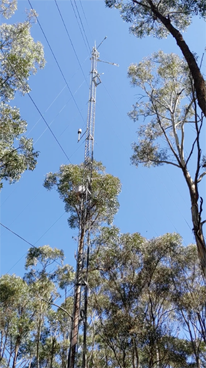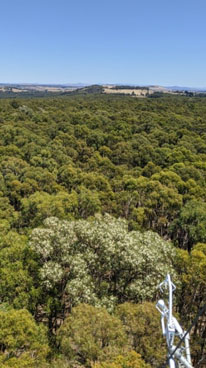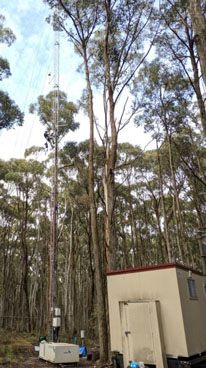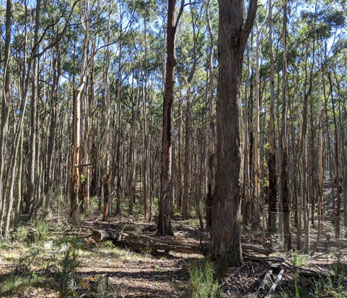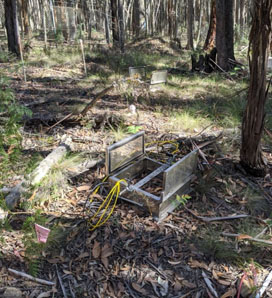
This month, we're headed to the Wombat Forest located near Daylesford in Central Victoria to showcase a decade of research infrastructure-enabled science on forest carbon cycles, soil, vegetation growth dynamics, and their responses to drought and other disturbances.
Like OzFlux, the Wombat Forest site is celebrating a milestone birthday this year – reaching 10 years of continuous data collection! Wombat Forest is both an OzFlux site and a TERN SuperSite  and is managed by Professor Stefan Arndt
and is managed by Professor Stefan Arndt  and Dr Nina Hinko-Najera
and Dr Nina Hinko-Najera  from the University of Melbourne.
from the University of Melbourne.
A decade of data collection facilitates vital ecosystem science
Wombat Forest's 35 m tall flux tower was installed in 2010 with the overarching aim of investigating the impacts of climate change and disturbances, such as fire and drought, on the dry sclerophyll eucalypt forests in southeast Australia.
To collect the data to enable such investigations, a core flux tower site and three satellite sites within a 1 km radius of the tower were installed. The satellite sites have additional infrastructure that reduces rainfall at them by 40% to simulate drought conditions and allow studies of ecosystem responses.
'We deliberately picked the location for our long-term research site in the Wombat Forest, because the forest type is very common in south eastern Australia. In fact, about 40% of the forest area of State Forests in Victoria are lowland or Foothill mixed species forests, such as the Wombat Forest.' - Stefan Arndt
Across its 10-year operation, the site's infrastructure and the data it collects have allowed researchers from across Australia to assess the net ecosystem carbon exchange  of the forest, tease apart stem and canopy growth dynamics
of the forest, tease apart stem and canopy growth dynamics  , understand the influence of climate on growth processes
, understand the influence of climate on growth processes  , quantify soil respiration
, quantify soil respiration  and soil methane uptake
and soil methane uptake  from the forest floor, and investigate the responses of trees to drought
from the forest floor, and investigate the responses of trees to drought  and other disturbances
and other disturbances  .
.
Flux data from Wombat Forest have been shared through OzFlux  , FLUXNET
, FLUXNET  and TERN
and TERN  and contributed to global scale flux synthesis
and contributed to global scale flux synthesis  research.
research.
'The site is designed to not only study the carbon, water and energy fluxes between the forest and the atmosphere, but get a more holistic understanding of how the forest as an ecosystem is shaped by and responds to its environment.
This is why we installed a whole range of additional instruments, such as dendrometers, sap flux sensors and VegNet sensors to study growth dynamics. We installed an automated chamber system to study the belowground greenhouse gas fluxes, i.e. soil respiration, methane and nitrous oxide fluxes.
The sensors allow studies of the water relations and drought responses of Eucalyptus obliqua as a keystone species in a number of satellite sites. It turns out the dry sclerophyll eucalypt forest is very resilient to changes in climatic conditions. It is a constant sink for carbon and the soil is a weak but also continuous sink for methane, while nitrous oxide fluxes are very low, indicating a tight nitrogen coupling.
We could detect almost constant stem growth throughout the year in dominant trees, while the canopy expands mainly in summer. For many years it kept its leaf area remarkably stable, a consequence of a good water supply. Only last year we saw a drop in leaf area in summer, an indication of signs of drought stress in the trees.' - Stefan Arndt
Carbon flux time series plot showing net ecosystem exchange (NEE), gross primary productivity (GPP) and ecosystem respiration (ER) over 10 years at the Wombat Forest. Data are shown as a daily flux with a 30-day running mean (thick line).
An ecosystem in Australia's fire red zone
Wombat Forest was declared a state forest in 1871. Prior to this, it was used to supply timber product for use in the gold rush; support for mine shafts, sleepers for railways, pylons for pier construction. Today it's managed by the Victorian Government Department of Environment Land, Water and Planning (DELWP  ), who are responsible for scheduling control burns and selective harvesting. It is now a secondary regrowth forest – it was last commercially harvested in 1980.
), who are responsible for scheduling control burns and selective harvesting. It is now a secondary regrowth forest – it was last commercially harvested in 1980.
The Wombat Forest covers approximately 70,000 ha of land in Australia's southeast – situating it within Australia's summer fire zone. The flammability of the forest is linked to its three dominant Eucalyptus species: a Messmate Stringybark (E. obliqua  ), a Narrow-leafed Peppermint (E. radiata
), a Narrow-leafed Peppermint (E. radiata  ) and a Candlebark (E. rubida
) and a Candlebark (E. rubida  ). Wombat Forest falls within the cool temperate climate zone characterised by warm-hot dry summers and cold wet winters, where annual average rainfall is 844 mm and mean annual air temperature of 11 °C. The hot dry summers in this region make the forest particularly susceptible to fire and drought.
). Wombat Forest falls within the cool temperate climate zone characterised by warm-hot dry summers and cold wet winters, where annual average rainfall is 844 mm and mean annual air temperature of 11 °C. The hot dry summers in this region make the forest particularly susceptible to fire and drought.
Flux data from the Wombat Forest have been used to assess the carbon and water response of southeast Australian eucalypt forests to extreme heat events in what have been described as Australia's "angry summers  ."
."
Recent research has shown that the trees at the Wombat Forest are able to sacrifice water for carbon gain during heat extremes  , which has implications for the long-term carbon and water balances of forest systems in the region. Capturing forest response to drought conditions and extreme heat is made possible through support of long-term observation sites like Wombat Forest.
, which has implications for the long-term carbon and water balances of forest systems in the region. Capturing forest response to drought conditions and extreme heat is made possible through support of long-term observation sites like Wombat Forest.
Views of the Wombat Forest flux tower (credit: Nina Hinko-Najera).
Tasks for the next 10 years
Measurements are set to continue at the Wombat Forest so researchers can understand how the dry sclerophyll vegetation responds to increased environmental pressure from climate change. Long-term data sets like those from Wombat Forest are critical for detecting changes in vegetation form and function over decadal timescales, but also for capturing a range of climate extremes that occur periodically – such as droughts and fire.
'Understanding the response of the forest to fire is something we are very interested in. In 2015 we prepared the site for a planned burn and dismantled our satellite sites and some of our sensors. We had negotiated the burn area with DELWP so that the entire footprint of the flux tower would have been burned. But in spring of that year a planned burn escaped in Lancefield, north of the Wombat Forest and destroyed some houses. This led to a re-evaluation of all fuel reduction burns and unfortunately, the planned burn never happened.' - Stefan Arndt
'Colleagues at our School have established a unique long-term experiment with the Fire Effects Study Area (FESA) experiment in the Wombat Forest, where parts of the forest are regularly burned in different intervals over the last 35 years. This allowed to investigate the long-term effects of fire on carbon stocks
and other ecosystem services
. But the flux tower also allows us to study the more immediate short-term responses of the forest to a fire disturbance.' - Nina Hinko-Najera
In addition to continued flux observation, upcoming research activities using the site will include a more detailed investigation of the soil respiration responses using trenched plots and a new automated soil respiration system. Another interesting study area will be the investigation of methane emissions from tree stems.
Preliminary measurements at Wombat Forest indicate that while tree methane emissions are prevalent – and at times very high – in trees in wetland areas, they can also occur in upland forests, especially in older trees. Hence, this is a potentially costly carbon loss to the system that is currently undescribed.
A third area of interest are the adaptive responses of trees to changes in climate. The eucalypts in the study area show an incredible plasticity in functional trait expression in response to environmental stresses  and the next step will be to link the plasticity in trait expression to the genetic profile of trees in the forest in order to evaluate the breadth of adaptive capacity of the eucalypts.
and the next step will be to link the plasticity in trait expression to the genetic profile of trees in the forest in order to evaluate the breadth of adaptive capacity of the eucalypts.
View of the Wombat Forest understory (left, credit: Nina Hinko-Najera) and the automated soil chambers (right, credit: Nina Hinko-Najera).

